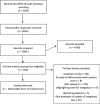Understanding integrated service delivery: a scoping review of models for noncommunicable disease and mental health interventions in low-and-middle income countries
- PMID: 36717832
- PMCID: PMC9885613
- DOI: 10.1186/s12913-023-09072-9
Understanding integrated service delivery: a scoping review of models for noncommunicable disease and mental health interventions in low-and-middle income countries
Abstract
Background: Noncommunicable diseases (NCDs) and mental health conditions represent a growing proportion of disease burden in low- and middle-income countries (LMICs). While past efforts have identified interventions to be delivered across health system levels to address this burden, the challenge remains of how to deliver heterogenous interventions in resource-constrained settings. One possible solution is the Integration of interventions within existing care delivery models. This study reviews and summarizes published literature on models of integrated NCD and mental health care in LMICs.
Methods: We searched Pubmed, African Index Medicus and reference lists to conduct a scoping review of studies describing an integrated model of NCD or neuropsychiatric conditions (NPs) implemented in a LMIC. Conditions of interest were grouped into common and severe NCDs and NPs. We identified domains of interest and types of service integration, conducting a narrative synthesis of study types. Studies were screened and characteristics were extracted for all relevant studies. Results are reported using PRISMA-ScR.
Results: Our search yielded 5004 studies, we included 219 models of integration from 188 studies. Most studies were conducted in middle-income countries, with the majority in sub-Saharan Africa. Health services were offered across all health system levels, with most models implemented at health centers. Common NCDs (including type 2 diabetes and hypertension) were most frequently addressed by these models, followed by common NPs (including depression and anxiety). Conditions and/or services were often integrated into existing primary healthcare, HIV, maternal and child health programs. Services provided for conditions of interest varied and frequency of these services differed across health system levels. Many models demonstrated decentralization of services to lower health system levels, and task shifting to lower cadre providers.
Conclusions: While integrated service design is a promising method to achieve ambitious global goals, little is known about what works, when, and why. This review characterizing care integration programs is an initial step toward developing a structured study of care integration.
Keywords: Integration science; Low- and middle-income countries; Mental health; Noncommunicable diseases; Service delivery; Systematic review.
© 2023. The Author(s).
Conflict of interest statement
The authors declare that they have no competing interests.
References
-
- GBD 2019 Diseases and Injuries Collaborators. Global burden of 369 diseases and injuries in 204 countries and territories, 1990-2019: a systematic analysis for the Global Burden of Disease Study 2019. Lancet. 2020;396(10258):1204–22. 10.1016/S0140-6736(20)30925-9. Erratum in: Lancet. 2020;396(10262):1562. - PMC - PubMed
-
- World Health Organization. Draft updated Appendix 3 of the WHO Global NCD Action Plan 2013–2020. World Health Organization; 2022. https://cdn.who.int/media/docs/default-source/ncds/mnd/2022_discussion_p.... Accessed 2 Jan 2023.
-
- World Health Organization. mhGAP intervention guide – version 2.0. World Health Organization; 2016. https://www.who.int/publications/i/item/9789241549790. Accessed 5 Oct 2022.
-
- Watkins DA, Qi J, Kawakatsu Y, Pickersgill SJ, Horton SE, Jamison DT. Resource requirements for essential universal health coverage: a modelling study based on findings from Disease Control Priorities, 3rd edition. Lancet Glob Health. 2020;8(6):e829–e839. doi: 10.1016/S2214-109X(20)30121-2. - DOI - PMC - PubMed
Publication types
MeSH terms
Grants and funding
LinkOut - more resources
Full Text Sources
Medical
Miscellaneous


